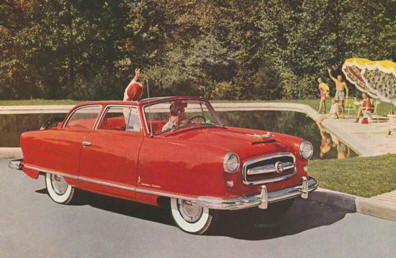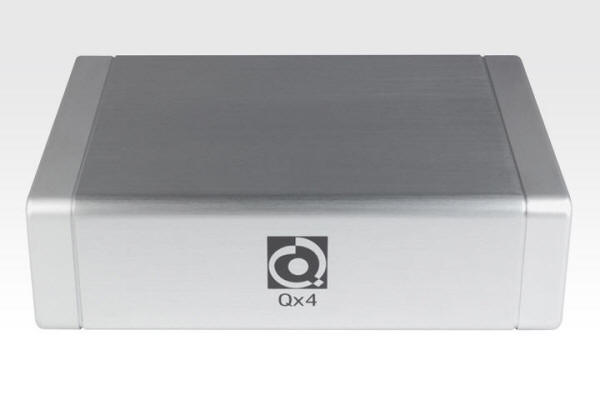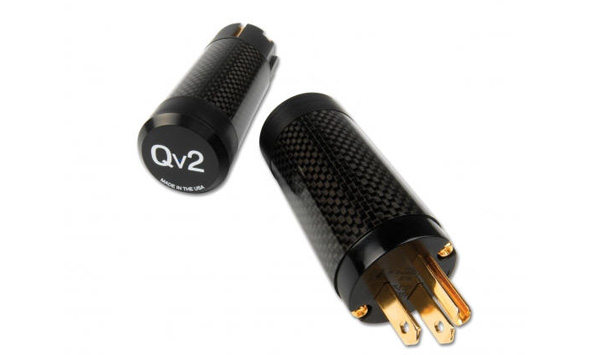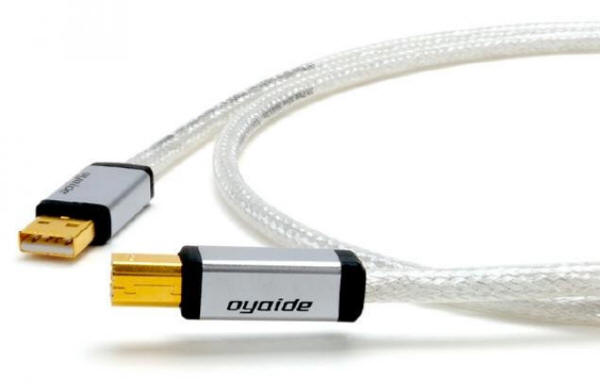|
You are reading the older HTML site
Positive Feedback ISSUE 60
Audio Ramblings - The Qv2 and Qx2 from Nordost
and the Continental USB Cable from Oyaide
A good two years ago I seriously compromised my back while lifting a 300lb wood chipper out of a pickup (images of Fargo are not too far off in terms of size and type), with two neighbors, with the misguided intent of saving a few bucks by doing what I should have been paying Jimmie's Tree Service to do for the cost of the chipper! Yeah, we get older but not always wiser. So there I am, with such pain that getting up and around was quite an ordeal… off to my Doctor who informs me a week or so after a CT scan that two discs are not what they used to be, and that the pain I am suffering from is a result of pressure on the sciatic nerve. Treatment options… possible recourse? Off to see a neurosurgeon who suggests stretching and exercise to strengthen the core… makes sense to not only work the muscles and relieve stress on the back, but to also strengthen the core to shift the 'work' around a bit. After a couple of months it is the same, if not worse. Next up is a referral to an anesthesiologist for a series of steroid injections into tissue surrounding the damaged the discs…. Yeah baby! I'm cured… makes sense to reduce the inflammation and hence the pressure on the nerves and all… no pain. Well, no pain till I had the second injection and WHAM… the worst ever. The third and last injection got me back to where I was prior to the first and so back to the neurosurgeon who suggests… physical therapy, more exercises, more stretching, all resulting in no change. What does he suggest next? How about coming back to him every two months till eventually I am in such a bad place that doing something as simple as getting dressed in the morning produces such excruciating pain that I am literally left on the floor in tears. What to do? How about we try deep tissue massage combined with acupuncture? The neurologist shakes his head and says, "Sure, go ahead if you want (besides it is not covered by insurance), it might help…" but he has his doubts. So off to a massage therapist who, while not making any promises, knows what he is doing, and what is going on muscle-wise to cause the pressure on the nerve, and resultant pain, and then goes to work. Nice, more mobile and less pain… and after only a few visits. He then suggests a local acupuncturist, who also makes no promises (she works with USC and professional athletes on a case by case basis, the massage therapist has similar credentials so they ain't fly-by-night practitioners), but is willing to try to do what she can. After a couple months or so of being a human pincushion combined with feeling like the Pillsbury Dough boy during the deep-tissue massage (acupuncture is completely painless whereas during deep tissue massage I am willing to double the fee in exchange for him not to continue the massage) and I am 95% pain free. Combining what these two artists can do with their hands and needles, with 400mg of ibuprofen and a heating pad for 20 minutes in the morning, and damn I am feeling good throughout my day as a teacher. Almost back to my old, ah… younger self, but yeah, no more heavy lifting. Not cured as the discs are still compromised, but man the pain is pretty much gone and I can live again! So what does this have to do with audio? Well, like some things in audio there is clear and definable 'scientifically-validated-exponentially-stuff-shirted' evidence as to why it does what it does… or works the way it works. Sort of like the injections and exercise. On the other hand, sometimes we just can't explain it for everyone's satisfaction—that is, when we do it, it simply flies in the face of what someone might think or believe to be true based on their background or learning's. It simply can't do that because it is outside their experience(s) or base of knowledge (education, training, etc.) or frame of reference. Like when the neurosurgeon said sure, go ahead and try massage and acupuncture… "Don't really see how that would help (as it is not part of my background or schooling or belief or perception of acceptable medical practice), but hey it's your money." Heck, even the acupuncturist will freely admit that even its practitioners do not know every time why hitting 'that' nerve with 'this' needle results in whatever. That is, while acupuncture has been practiced for thousands of years, even its practitioners are still learning and will freely admit that their results are not 100% predictable, let alone repeatable. Sometimes they win and sometimes they strikeout. Well, my Western doctors' struck out and going with something that lacks a clear and acceptable explanation (say on scientific medical terms) resulted in a home run. Yeah, for many it can't be explained for their satisfaction, but it works. I feel better—that is real and tangible.
Which takes us to Nordost's QRT Qx2 ($1799.99 each), Qx4 ($2699.99 each), Qv2 ($350 each), and Oyaide's Continental 5S USB cable ($395 for the 1.2m I have here, but more on it later). Now Nordost is not willing to do a 'tell all' on these products as to what is inside and how it does what it does, but what they will say is that…"the Qv2 works directly on the AC line, introducing a carefully calculated range of pulsed frequencies, clocked from the original 50 or 60Hz waveform" and… "the Qx unit contains an array of QRT field generators (two in the Qx2, four in the twice as powerful Qx4) that act to alleviate the impact of poor quality mains power on your sensitive electronics, limiting RFI and timing errors associated with the AC line." And from the QRT site…" The Quantum Resonant Technology Qx2 and Qx4 are sophisticated Scalar field generators, employing technology derived from research in the discipline of quantum mechanics that allows the ordering and stabilization of magnetic field effects…" No doubt this last bit will cause many who are into audio to sound some alarm…" Scalar field generators, employing technology derived from research in the discipline of quantum mechanics that allows the ordering and stabilization of magnetic field effects…" But you know, so what. Now, I have known both the Nordost and QRT people since the companies pretty much started making what they make, and I can say that neither is the least bit about bullshitting anyone about anything they sell or do. So if what they say about what they make and sell is not good enough for you, and what it does, and how it does it, flies in the face of what you believe and know to be true, well… gee, all I can say is that they work and do make an audible difference to my music—so who gives a rat's egg? A difference that makes it better, that it makes it more fun, that it makes it more involving, that it gives me more more more. More musical engagement… I mean what else could you ask for? Now I am not going to go into a fully fleshed out review of the complete line (you can read that in Adam Goldfine's review of the QRT units here in PF), but I will say that with one Qv2 on the amplifier circuit (the amps go straight into a dedicated 20 amp circuit via a pair of Jena AC outlets along with an Audio Magic Blue-Dot filter doing what it does), the soundstage gets deeper, wider, taller than without one—how much so? Enough to draw attention to the change, and one that not only makes the soundstage open up a decent amount, but one where the instruments take on more of a palpable presence than before—more definition and realness-ness. Nice. Air, space, clarity, aliveness… all good things and, not that the system lacked these prior, nor to take away from all that I had done to get it to where I was thinking, "Wow, does it really get any better than this?" But, well... yeah sure it can… just have to find the right thing to address what ever you have yet to know is causing something to muck up the music… just another step down the road. I also experience better clarity and color saturation on the big screen when another Qv2 is used on the outlet feeding the AC to the Equitech. Which is not to suggest that the Equitech and Audio Magic are not doing what they do, just that the Qv2 works quite well with them—nice synergy!
Less noise, more order, and like I said, more fun with our music. And this is with a handful of Audioprism's Quietlines tossed around the house on various circuits. Meaning that even with these here and there, there is still AC crap to deal with. The Qv2's are way cool and do work as advertised. Simply indispensible. Ditto the Qx4. But damn it man… does it have to cost $2699.99?! I like it. I like it a lot. Especially when plugged into the Bybee AC filter. Yeah, I know… that is not really the suggested placement. Nordost suggests that the Bybee should be plugged into it, or the preamp—that is that the Qx2 feeds the AC to the rest of the system in a defined order, but you know what; it works wonders just feeding off one of the unused outlets on the Bybee. Yeah, I have tried it in various configurations and sure it sounds to varying degrees quite good in all of them… it is just that, as I have connected here, there is a magical pairing or synergy (getting tired of that term, but for lack of a better one, it will do) between the two devices. Seems that while the Bybee is still wonderful, the Qx4 does what it does just as well. No negating either, just a peaceful summation of their two abilities—certainly different approaches to address possibly different areas, that when mated together, the two make music. So yeah, with the Qx4 in place the soundstage becomes bigger still. The speakers disappear that much more, instruments and textures take on even more presence and definable space, the sensation of the room being pressurized is more readily apparent and appreciated, timing and rhythm is even more involving… like there is less of that something in the way: a lot less of that something. I hear more with, than without. I hear more of the music, but what is cool is that I don't hear a change to the music. There is no shifting of whatever so this stands out from that—no harmonic or tonal emphasis or de-emphasis. Neither do the units soften or edit what is there. There is no sense of there being a sameness to the music when they are in the system—you know, the way some devices can make everything sound dull or bland by taking away the life and sparkle, or by adding some sonic signature of their own into or onto the music. No, the Q products just do what they do to the AC, thereby allowing for more of the music to be felt and appreciated. I like what they do. Not necessarily affordable, but they do work as advertised – here at least. AC is a funny thing, well not a Ha Ha funny thing as AC can be a very scary thing when you wrap your hands around a live wire and do the jumpy-dance… no it is a funny thing in how some AC filter/treatment devices can either be mind altering or ho-hum in what they can do. Your AC is not my AC…. what is happening on my grid is not necessarily happening on yours, so your mileage may vary—got to try before you buy. I want to add that the build quality is over the top—they not only weigh enough to be a lethal weapon, but have the fit and finish of a fine European automobile, which in the wrong hands can be a lethal weapon. As to break-in, while I am not so sure what needs to be broken-in per se, besides the fact that they made an audible improvement right out of the boxes (of which only for the Qx2 and Qx4 only contain the unit sans a power cord, so supply your own, and no I have not tried various cords to see if that would make a difference, though I would assume that it might, it could… damn, more to play with), I can add that the system is sounding better and better as time goes on—a good month now powered on 24/7. So perhaps they do break-in… or at the very least settle-in! Oh, and as to the Qx2 vs. the Qx4? Same effects but to different degrees—that is for some the Qx2 might be all you need or want, for others the four-times as powerful Qx4 will be the ticket. I spent my time with the Qx4 as another reviewer had asked to try the Qx2. I did, though, initially try the Qx2, and found it too subtle here when compared to the Qx4… so I went that route. Meaning the Qx4 worked better here than the Qx2. Alright so moving right along the proverbial hot topic of "That can't make a difference cause I said so", we encounter the idea that one digital cable can sound different than another. Well, for me they do, but as to why I will leave that up to the guys with the coats and credentials. Yeah sure, all it is doing is sending 1's and 0's down a wire (I can just imagine that right now… tiny little 1's and 0's bopping from A to B while humming along to "All Lined Up" by Shriekback) so how can any wire costing more than a freebie really matter? As long as it meets the specs, it works, it can't make a difference to the 1's and 0's. At least that is what some people think. But then again somehow, some way cables do matter, they can and do make a difference. I can hear it and so can others, so what is happening… well I don't really care. The Oyaide Continental 5S USB cable is a wonderful product in that what is does elevates itself way up there with the more pricey competition. I would characterize the cable as having much of the presence and feel of my $2800 Cynosure v2 (no longer available due to Lee's passing) at a 7th of the price. But at a 7th of the price you are going to be giving up some things: it is neither as rich nor robust, or as liquid and smooth, but damn, just the same this is a mighty fine cable. You get so much musical pleasure for so comparatively little. Truth is, going from the Cynosure to the Oyaide, one experiences little if any differences; it is only going from the Oyaide back to the Cynosure that you can fully appreciate what the Cynosure is all about. Even so, unless you have the privilege of doing that, who the gives a lambchop? You will love what the Oyaide does to the 1's and 0's… or not does!
The Oyaide Continental 5S USB is a well balanced and highly musical USB cable where nothing jumps out at you. Neither lean nor mean tonally, though slightly on the richer side harmonically (warmer than colder and heavier than lighter), I like this cable a lot. It has caused quite a stir here when in use… it really makes the music flow stirring not only emotions, but one's feet. It also reminds me of the Furutech USB cable causing me to wonder if there is a house sound to cables from Japan; that being: articulate, orderly, honest, and polite in the sense of never being annoying or rude musically (now there is a new term musically rude—dibs!). It is perhaps not as dark as the Furutech, though on its own I would never have characterized the Furutech as dark—just perhaps slightly darker than the rest but only when compared directly to the other USB cables here in the house. Simply put, the Oyaide Continental does it all quite well. It is well built and possesses an outward beauty—clearly reflective of Oyaide's products—that is quite pleasing to the eye. The Continental is constructed of silk filaments and sterling 5N silver conductors, all combined with an eye towards addressing noise, while mitigating vibrations and maximizing signal transfer. Oyaide's fanatic attention to detail, where nothing is left to chance as evident in their uncompromising approach to the cable's construction, has clearly resulted in the cable being a musical winner. Problem is, I like a lot of the USB cables here; they all do wonderfully musical things, and while sounding more alike than different, they are all different just the same. The Cardas USB sounds like Cardas with a great sense of clarity, speed, and that oh so magical Cardas midrange… combined with a no-nonsense way about getting the music from here to there; the cables 'personality' reminds me in many ways of the man himself—George Cardas: a true gentleman, straight to the point, deadpan sense of humor and yet witty, oh so intelligent, and quite cultured while being down to Earth. The Furutech has the speed, richness, and harmonic 'Zen' that characterizes—for me at least—the Furutech 'sound': formal, honest, and humble. The WyWires LITESPD possess speed and clarity—though clearly not bright or lean—with a massive soundstage. The WyWire reminds me of its designer as well—intelligent, honest, very forthright, and always the cultured gentleman who enjoys life. Toss in the Nordost USB, which is clearly cut from the Nordost 'sound': faster than fast, cleaner than clean, slightly lean but not bright, musical, and honest. Sorry, but while I am not going to rank these USB cables I can say that they all do wonderful things when sending the musical 1's and 0's from A to B. I am not sure why they do what they do to the sound when doing so… but they do do it! All of these differences are more subtle than revelatory, but they are all audibly apparent to anyone who is sorry enough to sit through an audition or cares to listen for themselves before dismissing a product. Differences when compared to a freebie USB cable? Generic USB cables loose out in all respects: less air, less music, less dimensional presence, less engagement; more sameness, more blahness; simply brash, rude, crude, uh… no thanks. What is happening in the above USB cables is an attention to wire structure (purity and type: copper or silver), geometry, braiding, dielectric (material), shielding, noise (from the power side), signal transfer… and so on. Seems to make a difference that I can hear, but which one is for you? Only you can decide but I would recommend ALL of them to anyone looking for the best!
Nordost
Oyaide
Lotus Group
|




